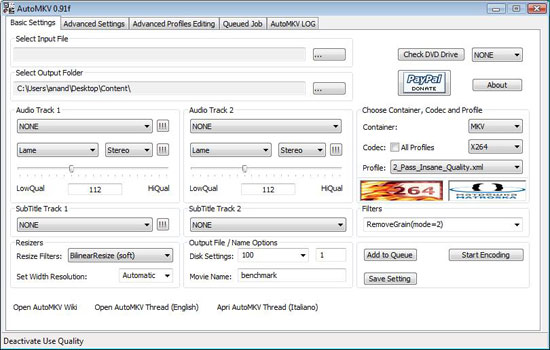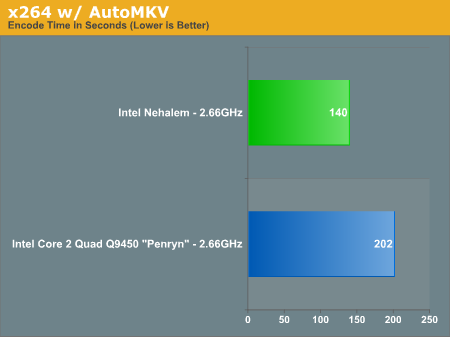The Nehalem Preview: Intel Does It Again
by Anand Lal Shimpi on June 5, 2008 12:05 AM EST- Posted in
- CPUs
Nehalem's Media Encoding Performance
We had time to run two of our media encoding tests: the DivX 6.8 and x264 workloads.
DivX 6.8 with Xmpeg

Our DivX test is the same one we've run in our regular CPU reviews, we're simply encoding a 1080p MPEG-2 file in DivX. We are using an unconstrained profile, encoding preset of 5 and enhanced multithreading is enabled.
The DivX test is an important one as it doesn't scale well at all beyond four threads, any performance advantage Nehalem has here is entirely due to microarchitectural improvements and not influenced by its ability to work on twice as many threads at once.

Clock for clock, Nehalem is nearly 28% faster than Penryn in our DivX test. Even better is when you put this performance in perspective: at 2.66GHz Nehalem is faster than the fastest Penryn available today the Core 2 Extreme QX9770 running at 3.2GHz. At 3.2GHz, Nehalem will be fast. The improvements in performance here are entirely due to the faster L2 cache and micro-architectural gains; being able to have more micro-ops in flight and improved unaligned cache accesses give us a significant improvement in video encoding performance.
The last time we saw these sorts of performance gains was when Conroe first launched.
x264 Encoding with AutoMKV

Using AutoMKV we compress the same source file we used in our WME test down to 100MB, but with the x264 codec. We used the 2_Pass_Insane_Quality profile:

Encoding performance here went through the roof with Nehalem: a clock for clock boost of 44%. Once more, Nehalem at today's artificially limited, modest clock speed is already faster than any Penryn out today. What Intel did to AMD in 2006, it is doing to itself in 2008. Amazing.










108 Comments
View All Comments
weihlmus - Friday, September 5, 2008 - link
is it just me or does lga1366 bear more than apassing resemblance to amd's logo...if only they could have crammed it into 1337 pins - "nehalem - the 1337 chip"
Proteusza - Friday, July 11, 2008 - link
I see that on the Daily Tech main page, the headline for this article now reads:"June 5, 2008
Post date on AnandTech's Nehalem preview, before it was ripped and republished on Tom's Hardware"
Does anyone know what happened? I cant find the same article on Tomshardware, I presume they took it down.
xsilver - Friday, June 20, 2008 - link
10 pages of comments and not one about the future of overclocking?No more FSB = no more overclocking??????
Enthusiasts might jump ship if overclocking usually brings 20% extra performance, all amd have to do is come within 10% on performance and below on price?
Akabeth - Thursday, June 19, 2008 - link
JebuzzzThis pretty much makes it pointless to purchase any high tier mobo and quad core today... It will be eclipsed in 6 months time...
Some of the numbers here make me wonder, "Are you f*cking kidding me?"
JumpingJack - Friday, June 13, 2008 - link
Anand, you could clear up some confusion if you could specify the version of windows you ran. The screen shots of some of your benchmarks show 64-bit Vista, yet your scores are inline with 32-bit Vista.... it makes a difference.JumpingJack - Friday, June 13, 2008 - link
Nevermind, page 2 shows 32-bit Vista... makes sense now. You should becareful when posting stock photos, the Cinbench reflects 64-bit.barnierubble - Sunday, June 8, 2008 - link
It appears to me that the Tick Tock cycle diagram is wrong.Conroe shooked the world in the second half of 2006, Penryn came in the second half of 2007, now 2008 we have Nehalem on the horizon set for the second half of this year.
Now that is 2 years between new architectures with the intermediate year bringing a shrink derivative.
That is not what the diagram shows; bracketing shrink derivative and new architecture in a 2 year cycle is clearly not fitting the reality.
mbf - Saturday, June 7, 2008 - link
Will the new IMC support ECC RAM? And if so, what are the odds the consumer versions will too? I've had a bit of bad luck with memory errors in the past. Since then I swear by ECC memory, even though it costs me a bit of performance. :)Natima - Saturday, June 7, 2008 - link
I just thought I'd point out that the Bloomfield chip reviewed (to be released in H2 2008) will infact dominate the gamer/high-end market.http://en.wikipedia.org/wiki/Nehalem_(microarchite...">http://en.wikipedia.org/wiki/Nehalem_(microarchite...
The smaller sockets will be for what I like to call... "office PC's".
And the larger socket for high-end servers.
A majority of custom PC builders will be able to buy & use Nehalems by the end of the year. Hoorah!
Natima - Saturday, June 7, 2008 - link
The article semi-implied that chips for the PC enthusiast would not be out until mid-2009. Just wanted to clarify this for people.